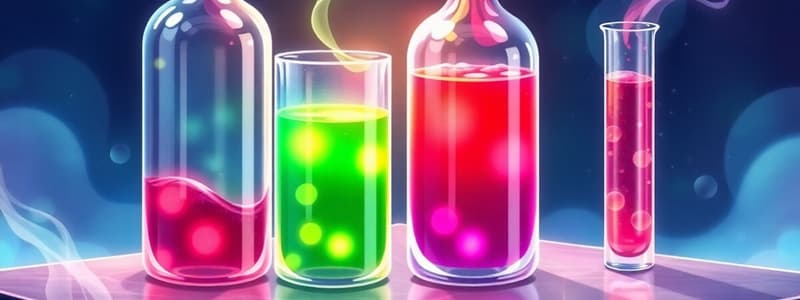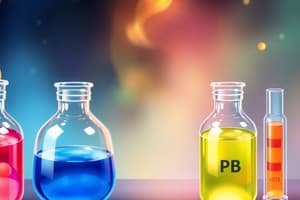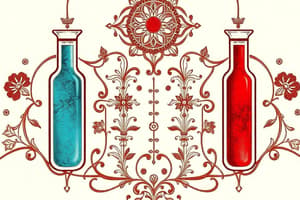Podcast
Questions and Answers
What taste is typically associated with acids?
What taste is typically associated with acids?
- Sour (correct)
- Salty
- Sweet
- Bitter
What effect do acids have on blue litmus paper?
What effect do acids have on blue litmus paper?
- Turns blue litmus paper green
- Turns blue litmus paper blue
- Has no change on blue litmus paper
- Turns blue litmus paper red (correct)
What effect do bases have on red litmus paper?
What effect do bases have on red litmus paper?
- Turns red litmus paper red
- Turns red litmus paper green
- Turns red litmus paper blue (correct)
- Has no change on red litmus paper
Which of the following is a natural indicator?
Which of the following is a natural indicator?
What color is litmus solution when it is neither acidic nor basic?
What color is litmus solution when it is neither acidic nor basic?
What happens to a curry stain on white cloth when soap is applied?
What happens to a curry stain on white cloth when soap is applied?
What type of plant does litmus come from?
What type of plant does litmus come from?
Which of the following is a synthetic indicator?
Which of the following is a synthetic indicator?
Which of these options would be suitable for someone suffering from acidity after overeating?
Which of these options would be suitable for someone suffering from acidity after overeating?
Why is litmus a commonly used indicator?
Why is litmus a commonly used indicator?
If a solution changes methyl orange from orange to red, what can you conclude about the solution?
If a solution changes methyl orange from orange to red, what can you conclude about the solution?
Which of these options would be best to neutralise a mild acid spill?
Which of these options would be best to neutralise a mild acid spill?
Why do acid-base indicators change colour?
Why do acid-base indicators change colour?
A student tests a solution and observes that red litmus paper turns blue. Which of the following is most likely true of the solution?
A student tests a solution and observes that red litmus paper turns blue. Which of the following is most likely true of the solution?
What division (taxonomic rank used in classifying organisms) does the plant from which litmus is extracted belong?
What division (taxonomic rank used in classifying organisms) does the plant from which litmus is extracted belong?
Apart from litmus and turmeric, which of the following can act as an indicator?
Apart from litmus and turmeric, which of the following can act as an indicator?
When excess of a base is added to methyl orange indicator, what colour change would you expect to see?
When excess of a base is added to methyl orange indicator, what colour change would you expect to see?
What would happen if you added baking soda (a base) to lemon juice (an acid)?
What would happen if you added baking soda (a base) to lemon juice (an acid)?
Which of the following best explains why soap removes a curry stain's yellow colour?
Which of the following best explains why soap removes a curry stain's yellow colour?
Which of the following scenarios would best demonstrate the nullifying effect of acids and bases?
Which of the following scenarios would best demonstrate the nullifying effect of acids and bases?
A solution turns blue litmus paper red, and when this solution is mixed with another solution, the mixture does not affect either red or blue litmus paper. What can be concluded?
A solution turns blue litmus paper red, and when this solution is mixed with another solution, the mixture does not affect either red or blue litmus paper. What can be concluded?
Which property of indicators facilitates their use in determining the endpoint of a titration process?
Which property of indicators facilitates their use in determining the endpoint of a titration process?
What is the significance of using indicators extracted from various sources like red cabbage, hydrangea, and geranium?
What is the significance of using indicators extracted from various sources like red cabbage, hydrangea, and geranium?
A researcher finds that a newly discovered lichen species yields a dye that is green in neutral solutions, turns yellow in acidic solutions, and blue in basic solutions. How could this dye be most effectively utilized?
A researcher finds that a newly discovered lichen species yields a dye that is green in neutral solutions, turns yellow in acidic solutions, and blue in basic solutions. How could this dye be most effectively utilized?
Why might synthetic indicators like phenolphthalein be preferable to natural indicators in certain scientific applications?
Why might synthetic indicators like phenolphthalein be preferable to natural indicators in certain scientific applications?
If a solution with a pH of 8 is diluted with distilled water, what will happen to the color of red cabbage indicator added to it?
If a solution with a pH of 8 is diluted with distilled water, what will happen to the color of red cabbage indicator added to it?
Which of the following situations illustrates a practical application of understanding acid-base reactions in everyday life?
Which of the following situations illustrates a practical application of understanding acid-base reactions in everyday life?
How does the chemical structure of an indicator enable it to exhibit different colors in acidic versus basic solutions?
How does the chemical structure of an indicator enable it to exhibit different colors in acidic versus basic solutions?
Consider a scenario where a novel organic compound is synthesized, exhibiting amphoteric properties, and contains both carboxylic acid and amine functional groups. Under what precise conditions—considering temperature, solvent polarity (protic vs. aprotic), and pH—would its zwitterionic form be maximized, assuming its isoelectric point (pI) is 7.4?
Consider a scenario where a novel organic compound is synthesized, exhibiting amphoteric properties, and contains both carboxylic acid and amine functional groups. Under what precise conditions—considering temperature, solvent polarity (protic vs. aprotic), and pH—would its zwitterionic form be maximized, assuming its isoelectric point (pI) is 7.4?
A biochemist is studying a newly discovered enzyme that catalyzes a reaction involving both an acidic and a basic residue at its active site. The enzyme's activity is optimal at pH 6.5. Site-directed mutagenesis is used to alter the pKa of the acidic residue from 4.0 to 6.0 and the basic residue from 8.5 to 7.0. What would be the most likely effect on the enzyme's activity at pH 6.5?
A biochemist is studying a newly discovered enzyme that catalyzes a reaction involving both an acidic and a basic residue at its active site. The enzyme's activity is optimal at pH 6.5. Site-directed mutagenesis is used to alter the pKa of the acidic residue from 4.0 to 6.0 and the basic residue from 8.5 to 7.0. What would be the most likely effect on the enzyme's activity at pH 6.5?
In a complex industrial process, a waste stream contains a mixture of weak organic acids and bases. To selectively recover a specific weak acid (pKa = 4.8) from this mixture using liquid-liquid extraction, which of the following strategies would be most effective, considering potential environmental and economic constraints?
In a complex industrial process, a waste stream contains a mixture of weak organic acids and bases. To selectively recover a specific weak acid (pKa = 4.8) from this mixture using liquid-liquid extraction, which of the following strategies would be most effective, considering potential environmental and economic constraints?
A research team is investigating the acid-base properties of a novel non-aqueous solvent system consisting of liquid ammonia and dissolved potassium amide (KNH2). Given that liquid ammonia auto-ionizes to a limited extent (2NH3 ⇌ NH4+ + NH2−), how would the addition of a strong amide base, such as lithium diisopropylamide (LDA), affect the acidity function (H−) and the electrochemical window of the solvent system, considering the implications for highly sensitive organic reactions?
A research team is investigating the acid-base properties of a novel non-aqueous solvent system consisting of liquid ammonia and dissolved potassium amide (KNH2). Given that liquid ammonia auto-ionizes to a limited extent (2NH3 ⇌ NH4+ + NH2−), how would the addition of a strong amide base, such as lithium diisopropylamide (LDA), affect the acidity function (H−) and the electrochemical window of the solvent system, considering the implications for highly sensitive organic reactions?
In the context of advanced polymer chemistry, consider a scenario where a researcher is synthesizing a pH-responsive hydrogel using monomers with pendant carboxylic acid groups and tertiary amine groups. The goal is to design a hydrogel that undergoes a sharp volume phase transition at pH 6.0, suitable for controlled drug release in a specific physiological environment. What factors must be meticulously controlled during polymerization, including crosslinking density, monomer ratio, and ionic strength of the polymerization medium, to achieve the desired pH sensitivity and mechanical properties?
In the context of advanced polymer chemistry, consider a scenario where a researcher is synthesizing a pH-responsive hydrogel using monomers with pendant carboxylic acid groups and tertiary amine groups. The goal is to design a hydrogel that undergoes a sharp volume phase transition at pH 6.0, suitable for controlled drug release in a specific physiological environment. What factors must be meticulously controlled during polymerization, including crosslinking density, monomer ratio, and ionic strength of the polymerization medium, to achieve the desired pH sensitivity and mechanical properties?
A chemical engineer is tasked with designing a buffer system for an industrial fermentation process that must maintain a stable pH of 5.2 ± 0.1 under conditions of varying organic acid production. Given the available buffering agents—acetic acid (pKa 4.76), phosphoric acid (pKa1 2.15, pKa2 7.20), and Tris (pKa 8.1)—which combination and concentration ratio would provide optimal buffering capacity and minimal interference with microbial metabolism, considering potential ionic strength effects and long-term process stability?
A chemical engineer is tasked with designing a buffer system for an industrial fermentation process that must maintain a stable pH of 5.2 ± 0.1 under conditions of varying organic acid production. Given the available buffering agents—acetic acid (pKa 4.76), phosphoric acid (pKa1 2.15, pKa2 7.20), and Tris (pKa 8.1)—which combination and concentration ratio would provide optimal buffering capacity and minimal interference with microbial metabolism, considering potential ionic strength effects and long-term process stability?
In the context of atmospheric chemistry, consider the equilibrium between dissolved carbon dioxide, bicarbonate, and carbonate ions in rainwater. Given increasing levels of atmospheric SO2 and NOx from anthropogenic sources, how would changes in rainwater pH induced by the formation of sulfuric and nitric acids affect the speciation of dissolved inorganic carbon (DIC), and what are the long-term implications for the global carbon cycle and weathering of carbonate rocks?
In the context of atmospheric chemistry, consider the equilibrium between dissolved carbon dioxide, bicarbonate, and carbonate ions in rainwater. Given increasing levels of atmospheric SO2 and NOx from anthropogenic sources, how would changes in rainwater pH induced by the formation of sulfuric and nitric acids affect the speciation of dissolved inorganic carbon (DIC), and what are the long-term implications for the global carbon cycle and weathering of carbonate rocks?
A materials scientist is designing a self-healing polymer coating that relies on acid-catalyzed reactions triggered by microcapsules containing a latent acid catalyst. The microcapsules rupture upon mechanical damage, releasing the catalyst and initiating polymerization of healing agents. Considering the requirements for long-term stability, trigger sensitivity, and biocompatibility, which acid catalyst would be the most judicious choice, and how would its concentration and release kinetics be optimized to ensure effective healing without compromising the mechanical integrity of the coating?
A materials scientist is designing a self-healing polymer coating that relies on acid-catalyzed reactions triggered by microcapsules containing a latent acid catalyst. The microcapsules rupture upon mechanical damage, releasing the catalyst and initiating polymerization of healing agents. Considering the requirements for long-term stability, trigger sensitivity, and biocompatibility, which acid catalyst would be the most judicious choice, and how would its concentration and release kinetics be optimized to ensure effective healing without compromising the mechanical integrity of the coating?
In the context of advanced analytical chemistry, consider a scenario where you are developing a novel sensor for the selective detection of trace amounts of a weak base analyte in a complex environmental matrix containing numerous potential interferents. Assuming the analyte's pKa is 8.2, what sensing strategy—involving pH modulation, selective complexation with a receptor molecule, and signal transduction—would provide the highest sensitivity and selectivity, while minimizing matrix effects and ensuring long-term sensor stability?
In the context of advanced analytical chemistry, consider a scenario where you are developing a novel sensor for the selective detection of trace amounts of a weak base analyte in a complex environmental matrix containing numerous potential interferents. Assuming the analyte's pKa is 8.2, what sensing strategy—involving pH modulation, selective complexation with a receptor molecule, and signal transduction—would provide the highest sensitivity and selectivity, while minimizing matrix effects and ensuring long-term sensor stability?
A medicinal chemist designs a new drug with multiple ionizable functional groups that exhibits pH-dependent solubility and permeability. Given the drug's intended oral administration, how would the interplay between its pKa values, the pH gradient along the gastrointestinal tract (stomach pH 1.5-3.5, small intestine pH 6.0-7.5, colon pH 5.5-7.0), and its interactions with efflux transporters (e.g., P-glycoprotein) influence its overall bioavailability, considering the implications for targeted drug delivery to specific regions of the digestive system?
A medicinal chemist designs a new drug with multiple ionizable functional groups that exhibits pH-dependent solubility and permeability. Given the drug's intended oral administration, how would the interplay between its pKa values, the pH gradient along the gastrointestinal tract (stomach pH 1.5-3.5, small intestine pH 6.0-7.5, colon pH 5.5-7.0), and its interactions with efflux transporters (e.g., P-glycoprotein) influence its overall bioavailability, considering the implications for targeted drug delivery to specific regions of the digestive system?
Which of the following statements accurately describes the relationship between acids, bases, and litmus paper?
Which of the following statements accurately describes the relationship between acids, bases, and litmus paper?
Why is baking soda solution suggested as a remedy for acidity?
Why is baking soda solution suggested as a remedy for acidity?
A solution 'X' changes blue litmus red. What can be inferred about the solution 'X'?
A solution 'X' changes blue litmus red. What can be inferred about the solution 'X'?
Which of the following best explains why turmeric is considered a natural indicator?
Which of the following best explains why turmeric is considered a natural indicator?
When a curry stain on white cloth turns reddish-brown upon application of soap, what chemical process is primarily responsible for this color change?
When a curry stain on white cloth turns reddish-brown upon application of soap, what chemical process is primarily responsible for this color change?
What is the chemical nature of the substance extracted from Lichen that is used as an indicator?
What is the chemical nature of the substance extracted from Lichen that is used as an indicator?
A scientist is testing an unknown solution. She finds that methyl orange turns yellow. What does this indicate about the solution?
A scientist is testing an unknown solution. She finds that methyl orange turns yellow. What does this indicate about the solution?
A researcher dissolves a new compound in water and observes that the solution turns red cabbage indicator blue-green. To investigate further, they perform a titration with a standardized HCl solution. The initial pH of the compound solution is 10.5, and it requires 25.0 mL of 0.1 M HCl to reach a pH of 7.0. Based on this information, what can be definitively concluded about the new compound?
A researcher dissolves a new compound in water and observes that the solution turns red cabbage indicator blue-green. To investigate further, they perform a titration with a standardized HCl solution. The initial pH of the compound solution is 10.5, and it requires 25.0 mL of 0.1 M HCl to reach a pH of 7.0. Based on this information, what can be definitively concluded about the new compound?
Consider a scenario where a chemist is investigating the effects of various organic solvents on the color transition range of phenolphthalein. The chemist prepares three solutions: one in water, one in ethanol, and one in a non-polar solvent like hexane. All solutions are adjusted to a pH of 8.0 using a universal buffer. Which of the following best explains the expected differences in the observed color of phenolphthalein across these three solvents, considering the potential influence of solvent polarity and hydrogen bonding on the indicator's molecular structure and ionization equilibrium?
Consider a scenario where a chemist is investigating the effects of various organic solvents on the color transition range of phenolphthalein. The chemist prepares three solutions: one in water, one in ethanol, and one in a non-polar solvent like hexane. All solutions are adjusted to a pH of 8.0 using a universal buffer. Which of the following best explains the expected differences in the observed color of phenolphthalein across these three solvents, considering the potential influence of solvent polarity and hydrogen bonding on the indicator's molecular structure and ionization equilibrium?
Flashcards
Acids
Acids
Substances that taste sour and turn blue litmus red.
Bases
Bases
Substances that taste bitter and turn red litmus blue.
Litmus Test
Litmus Test
A method to determine acidity or basicity using litmus paper.
Natural Indicators
Natural Indicators
Signup and view all the flashcards
Synthetic Indicators
Synthetic Indicators
Signup and view all the flashcards
pH Neutralization
pH Neutralization
Signup and view all the flashcards
Turmeric Indicator
Turmeric Indicator
Signup and view all the flashcards
Acid-Base Reaction
Acid-Base Reaction
Signup and view all the flashcards
Methyl Orange
Methyl Orange
Signup and view all the flashcards
Indicators
Indicators
Signup and view all the flashcards
Sour Taste
Sour Taste
Signup and view all the flashcards
Bitter Taste
Bitter Taste
Signup and view all the flashcards
Litmus Color Change
Litmus Color Change
Signup and view all the flashcards
Curry Stain Reaction
Curry Stain Reaction
Signup and view all the flashcards
Purple Litmus
Purple Litmus
Signup and view all the flashcards
Red Cabbage Indicator
Red Cabbage Indicator
Signup and view all the flashcards
Vinegar Remedy
Vinegar Remedy
Signup and view all the flashcards
Turmeric Reaction
Turmeric Reaction
Signup and view all the flashcards
Hydrangea Indicator
Hydrangea Indicator
Signup and view all the flashcards
Acid-Base Interaction
Acid-Base Interaction
Signup and view all the flashcards
Acidity Remedy
Acidity Remedy
Signup and view all the flashcards
Litmus Solution Origin
Litmus Solution Origin
Signup and view all the flashcards
Curry Stain and Soap
Curry Stain and Soap
Signup and view all the flashcards
Turmeric Color Change
Turmeric Color Change
Signup and view all the flashcards
Color Change in Neutral pH
Color Change in Neutral pH
Signup and view all the flashcards
Acid-Base Indicators
Acid-Base Indicators
Signup and view all the flashcards
Phenolphthalein Usage
Phenolphthalein Usage
Signup and view all the flashcards
Indicators from Plants
Indicators from Plants
Signup and view all the flashcards
Vinegar as an Indicator
Vinegar as an Indicator
Signup and view all the flashcards
Natural vs. Synthetic Indicators
Natural vs. Synthetic Indicators
Signup and view all the flashcards
Acidic Stains
Acidic Stains
Signup and view all the flashcards
Natural pH Indicators
Natural pH Indicators
Signup and view all the flashcards
Purple Litmus Color
Purple Litmus Color
Signup and view all the flashcards
Stomach Acidity Remedy
Stomach Acidity Remedy
Signup and view all the flashcards
Litmus Solution Use
Litmus Solution Use
Signup and view all the flashcards
Curry Stain Chemistry
Curry Stain Chemistry
Signup and view all the flashcards
Acid-Base Color Change
Acid-Base Color Change
Signup and view all the flashcards
Acid Strength
Acid Strength
Signup and view all the flashcards
Base Strength
Base Strength
Signup and view all the flashcards
Sour Taste of Acids
Sour Taste of Acids
Signup and view all the flashcards
Bitter Taste of Bases
Bitter Taste of Bases
Signup and view all the flashcards
Litmus Color Indicators
Litmus Color Indicators
Signup and view all the flashcards
Natural Indicators Examples
Natural Indicators Examples
Signup and view all the flashcards
Synthetic Indicators Use
Synthetic Indicators Use
Signup and view all the flashcards
Litmus Solution Color
Litmus Solution Color
Signup and view all the flashcards
Acid-Base Neutralization
Acid-Base Neutralization
Signup and view all the flashcards
Curry Stain Reaction with Soap
Curry Stain Reaction with Soap
Signup and view all the flashcards
Indicators from Flowers
Indicators from Flowers
Signup and view all the flashcards
Study Notes
Acids, Bases, and Salts
- Acids have a sour taste and change blue litmus to red.
- Bases have a bitter taste and change red litmus to blue.
- Litmus is a natural indicator extracted from lichen.
- Turmeric is another natural indicator.
- Synthetic indicators, like methyl orange and phenolphthalein, can also be used to test for acids and bases.
- Acids and bases can neutralize each other.
- Litmus solution is a purple dye extracted from lichen; it's purple when neither acidic nor basic.
- Other natural indicators include red cabbage leaves, turmeric, and colored flower petals (e.g., Hydrangea, Petunia, Geranium).
- These natural materials are called acid-base indicators or simply indicators.
- A stain of curry on a white cloth becomes reddish-brown when soap is scrubbed on it.
- The cloth turns yellow again when washed with water.
- Lemon juice, vinegar, or baking soda solution can be remedies for acidity.
- Acids are sour in taste, and bases are bitter.
- Natural indicators like litmus, turmeric, and red cabbage can change color in the presence of an acid or base.
- Natural indicators can be used to test substances without tasting them.
- When acids and bases are mixed they can neutralize each other reducing the acidic or basic nature of the mixture.
Studying That Suits You
Use AI to generate personalized quizzes and flashcards to suit your learning preferences.




